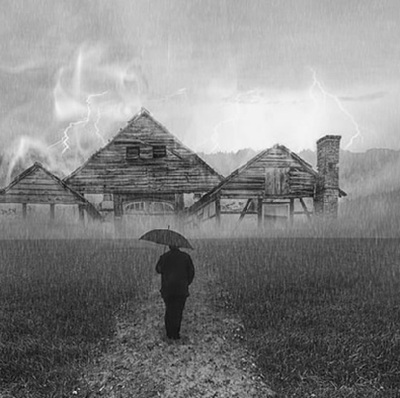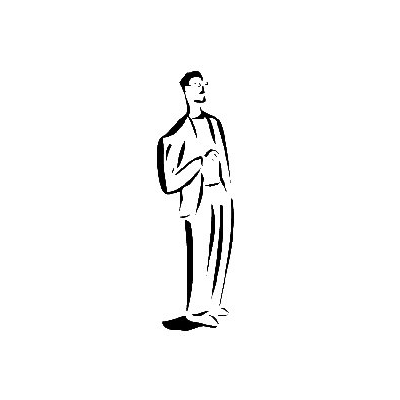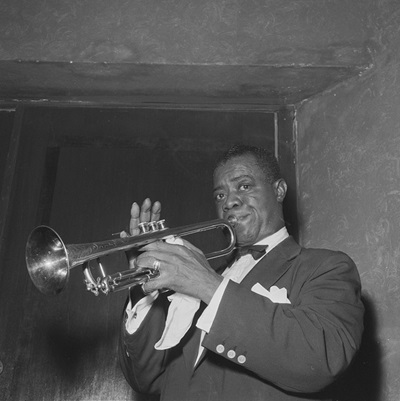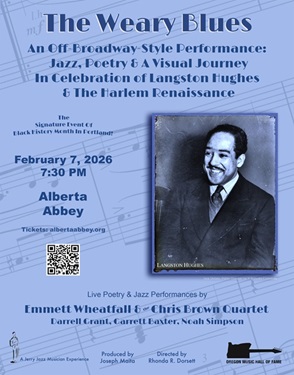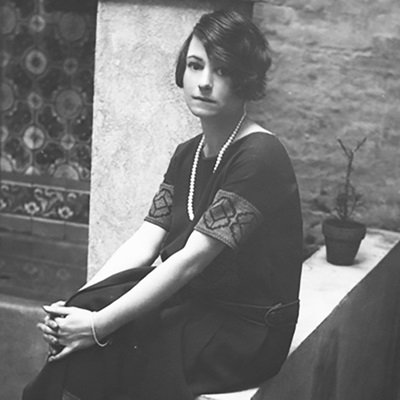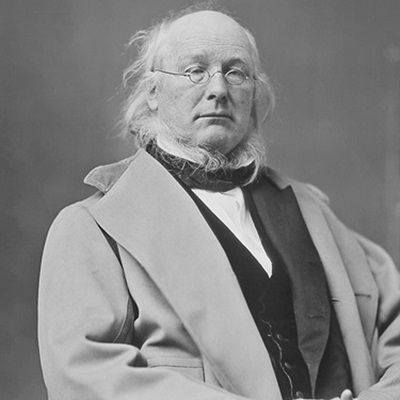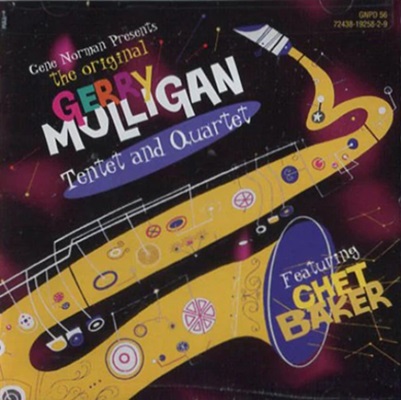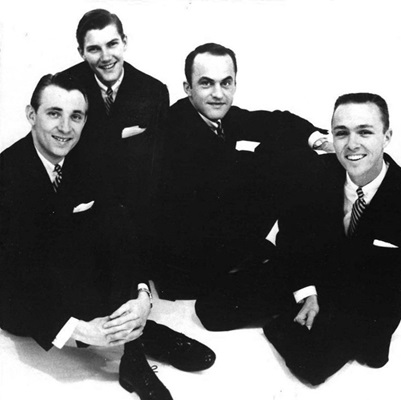.
.
“Sphinx,” a story by Brian Greene, was a short-listed entry in our recently concluded 55th Short Fiction Contest. It is published with the permission of the author
.
.
.
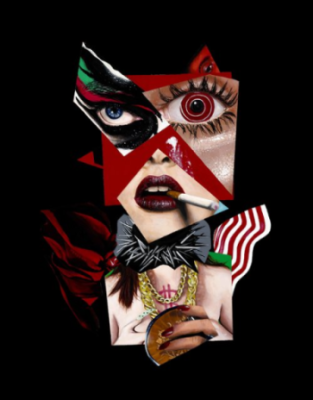
.
Sphinx
by Brian Greene
.
1.
…..I met Leonor when I was 23 and she was 51. At the time I was in a state of attempting to put myself back together, having come apart recently. About a year and a half before I became acquainted with Leonor, a combination of too many recreational drugs, a painful breakup with a girlfriend, and seemingly inborn predispositions of anxiety and depression caused me to leave the capital city where I’d been living and vaguely attending college. I retreated to my mother’s house in a smaller city 200 miles away. I spent about a year in my old bedroom, rarely leaving home and not communicating much with anybody. It eventually became clear that I wasn’t going to commit suicide – though that year I often slept with a knife under my pillow, in case I should wake up in the wee hours and decide it was time – or become so mentally unstable that I needed to be hospitalized. So I figured I might as well take another try at living. A psychiatrist I’d been seeing helped to encourage me. A New-Ager named Avis who said I had “the light,” she told me she could prescribe anti-anxiety meds for me, but that she’d rather see me do without them. “You’re anxious for good reasons,” she told me. “Channel the anxiety into energy and do something with it.”
…..So I broke out of my mom’s home and rented an attic bedroom at a sort of boarding house. The place was run by a live-in narcissistic moron who sometimes went on African safaris and who had, in nearly every room of the house, letterhead that had an image of him in a jungle man getup in the top left corner. I found employment as a 30-hour-a-week clerk at a crappy chain bookshop. That left me plenty of spare time, which I decided to use – taking my therapist’s advice – constructively. I figured I should engage in some artistic activities. I’d long since known I had a knack for creative writing, but I’d usually been too lazy or stoned or busy with girls to do anything about it. But now I was ready to apply my talent. I got a gig writing book and music reviews, as well as the occasional feature article on those same subjects, for the local weekly culture magazine. I also started writing short stories. As a less direct effort at becoming engaged in the arts, I offered my services to a small repertory theater located in the cultured section of the city. I didn’t have any experience with the production of plays, but I’d been to several of that outfit’s shows and always enjoyed them. I told them they could use me in any way they needed.
.
2.
.
…..It was through the theater that I got to know Leonor. Their stage manager called me one afternoon and asked if I could help them with an errand. They were starting work on a forthcoming production and needed someone to pick up a set piece. The artist who created the piece insisted that it be collected that day, and nobody else was available. I rode my bike to the theater and was given the keys to a van and the artist’s address. The stage manager told me the artist’s name – Leonor – and gave me a warning: “She can be a little difficult.”
…..Leonor made an immediate impression. Standing around 5’10, making her approximately two inches taller than me, she had a commanding aura that I felt right away. Her dark brown, frizzy hair, which she then wore about down to her shoulders, had a shocked look at the time. Her brown eyes came across as powerful and entrancing, both alluring and intimidating. At that encounter, she wore a frilly black dress that looked like it could have been anything between a fancy housedress and a costume piece. She spoke in a throaty, sensuous voice, in what sounded to me like a French accent. She seemed a little maniacal, also like someone who generally intimidated people and who was comfortable with her relations to others working that way. I thought she seemed like a half-crazy goddess. But I didn’t get to know her over that visit. She was on the phone the entire time I was in her house. She let me sit and wait for her for over a half hour, listening to her end of the phone chat, before finally putting the other person on hold long enough to show me where the set piece was and to tell me, “If you drop it, there will be trouble for you.”
…..I was fascinated by Leonor’s set piece. Part of the play had to do with a sphinx who bedeviled some of the characters. Leonor got commissioned to create a standup figure of a sphinx, which would appear on the stage while the voice of the hybrid creature could be heard tormenting the characters with its riddles. On the huge piece of shaped cardboard, Leonor had painted a half-woman, half-animal creature that had a face and set of hair that looked a lot like hers. Her sphinx also possessed a prominent pair of exposed breasts, and then the lower body of a cat, with tail. The sphinx looked the way it should – knowing and inscrutable. Leonor’s sphinx also had a presence that was similar to her own: domineering and possibly troublesome.
…..Over the three weekends of the play’s run, I sometimes worked as a volunteer ticket seller and usher. Leonor came to see the production for the first time on closing night. There was a cast and staff party after the show that evening. But I never made it to the party. Shortly after the final curtain, Leonor approached me and said, “Can you help me bring my piece home?”
…..“They’re planning to break everything down tomorrow. I’m sure I can borrow their van and bring it to you then.”
…..“I want it brought to my home tonight. I have a car that’s big enough. I just need a little muscle to help me with the lifting.”
…..I’m hardly a bodybuilder and wasn’t accustomed to being called on to supply strongman functions. But both Leonor and I knew she only made that comment to flatter me, as her playful grin showed. When she smiled, it made clear how high her cheekbones were. I remember thinking in that moment, “She’s just plain beautiful.”
…..At her house, after we got her piece through the door and into a room that she was using as kind of studio, Leonor asked me what I wanted to drink. She seemed to take it for granted that I would rather stay there with her than return to the theater and the party. I’d been looking forward to the party, hoping to make conversation with one of the play’s actresses: a young woman named Jessica who was talented, pretty, and who seemed to like me. But I wasn’t about to say no to spending a little time talking to Leonor.
…..I had a glass of expensive bourbon, with a splash of water and a few cubes of ice. Leonor drank red wine. One of the 11 cats she had in the house got in my lap when I sat down on the love seat opposite the chaise lounge on which Leonor stretched herself.
…..Leonor asked me a few questions about myself, surprising me by seeming genuinely interested in aspects of my life. But we quickly got onto the subject of her. I learned that she was born in Italy and had lived in various parts of Europe, and had been a resident of Paris for most of the past two decades. She had a second home, in the mountainous range of the Ardennes, where she liked to go to paint, “and to get away from people when I need to, which is often.” She was in the mid-sized American city because she’d been invited by the university there to hold a three-year appointment as a distinguished visiting lecturer in the Art History department. This was late June, and in the fall she’d be starting the last of those three years. I wondered why someone as cosmopolitan as she would accept such a position in a place in America other than a major city, and at a school that was not more academically renowned. Leonor, who often seemed to read my thoughts, answered this question without my asking it.
…..“I was reluctant to come here. But I was having a problem with someone in Paris and it was a convenient way to escape the person and the problem.”
…..She got the assignment to create the set piece for the play via a professor in the school’s Theater Studies department. She had also been commissioned to paint portraits of various higher-ups in the university’s administration, and some of those people’s family members.
…..“I hate doing portraits. But they pay me a lot of money, which helps to make up for the insufficient salary I’m being paid to teach.”
…..Over my second glass of bourbon, and having forgotten about the theater party, I asked Leonor about the artwork she did besides the piece I’d seen. I noticed some canvases up in her studio, but hadn’t gotten a chance to look at any of them closely.
…..“It’s easier if I just show you. I’ll get you a book. I have to go in another room and make a phone call. You can look at the book while I talk to this person. It shouldn’t take me too long.”
…..It took her close to 45 minutes. But I didn’t mind the wait. The book – a coffee table production, done by an American publisher from New York – held me transfixed. It contained pictures of a smattering of Leonor’s paintings, and a few of her drawings. There were some clear themes among the work. I learned that it was no accident that she’d been hired to paint a sphinx, as those beasts were a favorite subject of hers. She’d painted scores of them. They always looked like her. Sometimes they were sitting alone and other times they were around other similar creatures, or straight-up humans, and generally lording over all of the others. Leonor told me later, “The half-human, half-animal being is the ideal state. It’s how I see myself.”
…..Some of her other paintings contained fully human women. Again, many of them looked more or less like Leonor herself. Another thing all the women in her works had in common was that they were all commanding-looking people. They were almost always naked, never smiling, and usually with a look on their faces that suggested they were in full possession of themselves, independent, and in control of whatever situation was at hand. One showed a beautiful naked woman carrying bouquets of wildflowers while walking majestically through a penis-shaped doorway.
…..The book, which had been published four years before, also contained a short biographical sketch of Leonor. It was through this section that I learned her age. I also found out that she had never been married and didn’t have any children. The person who wrote the mini-biography stated that while Leonor was something of a mid-major artistic figure in Europe, she was little known or appreciated in the U.S. I thought maybe another reason why she accepted the visiting appointment at the smallish American school was as a means of establishing a kind of breakthrough over here.
…..When Leonor came back to the sitting room, she announced that it was time for her to get to bed. She looked like the phone conversation had left her mentally exhausted. I wondered if it was with the Parisian person from whom she had fled. Saying she’d had too much of the wine to be able to drive, she called a cab to take me home, and insisted on paying for the ride. Before leaving, I asked her if I could borrow the book on her.
…..“No. You can look at it when you’re here.”
.
3.
.
…..As implied by the comment Leonor made when I asked about the book, I became a regular visitor to her house. She had me over twice a month or so for a while, and then more frequently. She always wanted us to do our socializing in her home, rather than out at some public place. “I prefer to be surrounded by noises I choose to hear, rather than noises made by other people I don’t choose to be near.”
…..I was happy for any excuse to escape the boarding house and its would-be jungle man landlord. And of course Leonor’s company was always welcome, both because of her beauty and her character. The more I got to know her, the more interesting she seemed to me. Over time I came to see more and more that she was like the hybrid creatures and women from her artworks: in charge of her surroundings, as close to being a wild animal as to being human, aware of her acute sexuality and too self-determined and free-spirited to be contained by men. I also continued to be in awe of her artistic talent.
…..One time, when she was telling me about some of the people she knew in Paris, I wondered to myself why she had chosen me to be her friend. Again seeming able to know my thoughts without me uttering them, she explained.
…..“I like you because you’re not macho. Men who are determined to prove their virility bore me. The best people are the ones who don’t fully belong to one gender or the other.”
…..I thought of the few men that appeared in her paintings and drawings. They all had an androgynous aura to them.
…..Once, Leonor showed me some of her personal photo albums. These pictures commanded my attention even more than the ones of her artworks. The photos I saw were from various decades. I came to know just how beautiful she really was. Part of my newfound appreciation of her physical appeal had to do with her body. I suspected that Leonor had large breasts like the women and sphinxes in her paintings and drawings, but she always wore loose-fitting dresses and blouses when I was with her, so I wasn’t sure. In some of these old pictures she wore low-cut tops and revealing dresses, so now I knew about that part of her. One photograph, taken by a female artist friend of hers, showed Leonor swimming in a shallow swimming pool, naked, and the picture was only from her chest down, accentuating her breasts, which were large and perfectly rounded. Some of the other pictures brought out her blatant sexuality in other ways, showing her wearing outfits featuring garter belts, corsets, fishnet hose and the like. In some of the photos she had on what looked like S&M gear.
…..I still didn’t know much about Leonor’s love life, several months into seeing her regularly. I knew from that photo album and from some of her anecdotes that she’d led a very active romantic existence, but I didn’t know much detail about the men (or women?) or the relationships. A few of the men with whom she’d been involved had names that I’d heard before – artistic figures from Europe. But she hadn’t told me the first thing about the person she’d felt the need to run away from in Paris, although I’d long since assumed it was a hurt lover she was done with but who wouldn’t leave her alone.
…..Another time, Leonor showed me a photo album that was filled with pictures of her in costumes. Many of these were taken at or before social events where all the attendants came in disguise. Leonor wasn’t much for socializing out in public at the present time, but clearly she’d been more outgoing in that way in her younger life, particularly when there was an opportunity to wear a costume to such events. She explained to me that all the gear she had on in the various pictures were things she’d made herself. She was shown in a variety of masks, collections of feathers, animal body parts, and such. Sometimes she looked like a kind of wild bird, other times like a sexy cat, and often like the half-human, half-animal sphinxes by which she was so taken.
…..“Dressing up in this way allows you to exit the boring human world,” she told me, as I flipped, slack-jawed, through the album’s pages. “It lets you let go of our limited senses of space and form, and to become part of nature. It’s wonderful.”
…..The evening on which we looked at the costume pictures, before breaking open the photo albums, Leonor and I smoked some hashish she’d gotten from a graduate student at the university. It was strong stuff. All my senses were heightened. I felt the force of Leonor’s sexual presence the first time I saw her, and had only become more aware of her attractiveness over time. But the urges I felt toward her that night were stronger than what I’d experienced previously. Leonor as a wild cat was somehow even sexier than her in breast-revealing tops and knee-high black boots. I felt like I needed to either finally make a pass at her, or flee from her house and run home for a freezing shower.
…..Around the time we closed the album, Leonor excused herself and left the room momentarily. When she came back, she was wearing one of her costumes. She was an owl, with an owl mask and a collection of feathers on top of her head and around her shoulders. I thought maybe our first sexual encounter was going to come with her in costume. But when she came back in the room dressed that way, she sat in a chair opposite me, instead of next to me on the love seat, where she’d been when we’d been looking at the pictures.
…..Showing the ability once again to know what I was thinking before I said it, she looked at me through her owl mask and said, “There might be another time for us to be that way together. Right now I’m an owl. You can’t make love to an owl, can you?”
…..I didn’t have an answer for that. Leonor took off the mask and showed me the same smile she put on that night after the play, when she told me she needed my muscle to carry her set piece home. She didn’t smile very often. Usually she looked severe. But now she had on a playful grin as she said, “Tell me about your girlfriends.”
…..I’d had a lot of them. Romantic relations with girls had been a large factor in my life, just as those with men seemed to be in Leonor’s. I was 11 the first time I asked a girl to “go” with me. By age 16 I’d had roughly six of those pre-sex romantic relationships. At 15 I had my first taste of the feelings that come with deeply caring about someone with whom you are attached in that way. In my senior year of high school I dated a girl who looked just like Natalie Wood. We said we’d get married as soon as we both finished college, yet we broke up within three months after the summer following high school graduation. I’d had two long-term relationships over the past five years. The last of them ended in a way that left me shaken.
…..Leonor listened patiently as I told her my love life history, without offering any comments or advice. But when I mentioned that I’d been on a few dates with Jessica, the woman from the play, she grew more animated and talkative. She said, “Bring her here one night. The three of us can have an interesting time together.”
…..Another time when I was visiting her, Leonor surprised me again by asking to read some of my short stories that I’d been trying to get published in literary magazines, to no avail. I was doing great with the journalism writing for the weekly, but nobody wanted to publish my short fiction. After reading three of my stories, Leonor had advice for me.
…..“You’re onto something with these. But you press on them too hard. You’re in the way of your characters. Stand apart from them and give them room. Write about them like you’re watching them from another world.”
…..I wrote a new one, about a struggling musician who dreamed he had written a 32-minute song and then worked on putting the song together in his actual life. I made an effort to see the main character the way Leonor told me I needed to view my story subjects. I worked on the story intermittently, always on days when I had been in Leonor’s company the evening before. When the story was done, I entered it in a short fiction contest held by a literary magazine from New York. I won second prize. I got paid $200 and the story was published on the magazine’s web site and in a hard copy issue. As a gift to help me celebrate this achievement, Leonor drew a picture of a guy who looked a lot like me, lying in an open grassy field, asleep, with an assortment of musical instruments and notes floating in the air just above his head. I got the picture framed.
…..Leonor also helped me get an article published in a respected film magazine from London. She knew one of the editors and gave me an in. I got commissioned to write a piece about Jean Cocteau’s films. Leonor and I watched the movies together, and talked about them, over the time during which I worked on the piece.
…..I moved out of jungle boy’s house and got my own one-bedroom apartment. By then I was working in a better bookshop, and had been made assistant manager there. I was thinking of more stories I could write and where I could try to place them. The London film magazine editor told me to get back in touch if I had any other ideas for feature articles for them. I told Leonor, “My life is changing because of you.”
…..“Not changing. Developing. Anyway, I’m just a wild animal who came and gave you a little bite when you were sleeping, to give you a shock of awakening.”
.
4.
.
…..Leonor behaved in ways that were new to me on the night when I brought Jessica to her house. It started immediately. After getting us all a drink, Leonor ushered Jessica to a standalone chair in her sitting room, then led me to the love seat opposite and sat down next to me. As we began to make conversation, Leonor put her arm around my back and played with my hair. She’d never touched me before. Later, when her wine glass needed refilling, she asked me to get up and do that for her. When I returned to the love seat, before she took the filled glass from me, she held on to my wrist and kissed my hand, saying, “Thank you, angel.”
…..Leonor didn’t give all her attention to me that night, though. She focused on Jessica for a long stretch of the evening. She complimented my friend on her acting in the sphinx play, got her to talk about how she’d gotten interested in theater and what her future plans in the arts were. Leonor told her, “You should be in films. You’re naturally photogenic. You’d look wonderful on the large screen. But you need to bring your looks out more. I’m going to show you.”
…..Leonor left the room and returned with a huge silver hairbrush. She asked me to switch seats with Jessica, and then she sat beside my friend. Jessica, who has bushy red hair that she wore down to about the middle of her back then, had her hair up in a ponytail that night. Leonor took the ponytail holder out and brushed my friend’s hair in a way that made it flow freely and jump out from Jessica’s head on the sides. Then they left the room for a little while. When they returned, Jessica was wearing a sequined aqua blue dress in place of the flower design T-Shirt and Capri-length jeans she’d had on. I’d seen pictures of Leonor in that same dress. Jessica was as tall as Leonor, although not as full bodied. But the dress fit her well enough and, with her hair the way Leonor had brushed it, she looked like some kind of spirit goddess. If fact, she looked almost identical to a woman in one of Leonor’s paintings: a redheaded beauty wearing a fish scale dress with a regal and exotic air about her, as she stood naked in a room full of glass walls and flowers covering the floor. It was one of the few examples I’d seen of a woman Leonor painted who didn’t look just like the artist herself.
…..Leonor sat Jessica back down on the love seat and started playing with her hair, the way she’d done with me earlier. I wondered to myself if she was thinking of leading the three of us into a ménage a trois. But soon enough, she turned her attention back to me. We went to a different room, one that had a movie projector and large screen. Leonor broke out some hashish and we all smoked. A little later, she put on some home movies and showed them to us on the big screen. The films were of Leonor and some of her Parisian friends, on one of the nights where they’d all gotten in costumes. They were dressed as animals of various kinds and they were pretending to be of the wild. Leonor was in a cat mask and outfit in most of them.
…..Before she started the film, Leonor put Jessica in a chair by herself and led me to a little sofa. After she got the movie going, she sat on the sofa with me. She turned to her side and stretched herself out, putting her long legs over my lap. At one point, just as she appeared on the screen in her cat gear, she rubbed her bare foot over my inner thigh. Jessica was sitting on the same side of the room as us, facing the same way, plus it was dark in there. I knew she hadn’t seen the foot action, but I also was aware that she had to know that Leonor had put her legs over me.
…..After the film was over, Leonor got us all more to drink and then she sat very close to me on the sofa. She took hold of my hand and made our fingers intertwine. Leonor had some of the longest fingers I’ve ever seen. She grew her nails long and kept them well manicured. That night she wore a brilliant silver nail polish, that called attention to her hands and that went well with the black lacy dress she had on, and the silver shadow that she’d put on the lids of her glowing brown eyes. She kept hold of my hand as she and Jessica and I talked about Leonor’s home movies, used her thumb to caress the outside of my palm. I worried about what Jessica was thinking and feeling. But I couldn’t let go of Leonor’s hand.
…..Around that time, Jessica announced that she better be getting back home. She got changed back into her own clothes. Jessica and I had walked there together from her apartment, which was about a mile and a half away. I said I’d walk her home.
…..“Nonsense,” Leonor said. “It’s too dangerous. It’s three in the morning. There are creeps lurking on the streets at this time. And you’re both high, which makes you defenseless. I’ll call her a taxi.”
…..When the cab arrived, Leonor walked over to Jessica and kissed her on the cheek, told her what a delight it had been to meet her. I walked outside with Jessica and asked her if she wanted me to come with her.
…..“No. I better get right to bed. I have an audition tomorrow afternoon.” Then, looking up at Leonor’s house, she said, “And she’s expecting you.”
…..“I hope tonight wasn’t too weird for you. She was a little strange. I –“
…..“It’s ok. It was a memorable night. Thanks for bringing me. Talk to you soon, ok?”
…..Jessica looked straight ahead from the back of the taxi seat as the car drove her away.
…..I didn’t know what I was going to say to Leonor when I got back in the house. Countless different thoughts were going through my head, along with all the mixed emotions I was feeling. But Leonor did the talking. She was standing in the front room when I got back inside, and she was wearing one of her cat masks. As I gazed at her, she talked from behind the mask.
…..“I like her. But she’s not right for you. There’s no chemistry between the two of you. I saw that right away.”
…..Before I could start to respond to that, Leonor took a sip of wine, then said, “I’m going to bed,” and started walking in the direction of her bedroom. I was dumbfounded, and trying to decide whether I should call a cab or risk walking home. Leonor stopped walking for a moment, turned around to face me, and set her cat mask down on an end table in the hallway.
…..“Aren’t you coming?”
.
5.
.
…..Leonor had a gift to leave with me when it was time for her to return to Paris that June. She didn’t give it to me in person. She arranged for it to be delivered to my apartment, a few days after she’d left. It was a painting she’d done sometime over the past year, without telling me about it.
…..I am in the painting. I lay on my back, in a forest, naked and with some leaves over me. My eyes are closed. I look peaceful. You can’t tell if I’m meant to be dead or sleeping. Some feet away, looking over a stone wall and facing in the direction of my body, crouches Leonor. Her hair appears wild and her naked breasts are prominent. Next to her is a wild cat-like creature that looks partly human, but also savage. The cat is looking at me, a fierce gleam in its eyes. Leonor is looking straight ahead, as if to meet the eyes of the viewer of the painting. There’s a look on her face that suggests that she’s asking anyone looking at the images, “Well, what do you make of this?”
.
.
___
.
Brian Greene’s statement about his story “Sphinx”
.
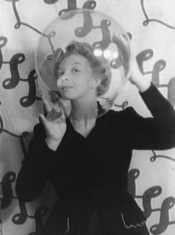
photo of Leonor Fini by Carl Van Vechten, Public domain, via Wikimedia Commons
.
…..A few years back, I became acquainted with the work of surrealist painter and costume designer Leonor Fini (1907-96). I became so fascinated by her art that I wanted to learn about her life. I read two biographies of her, as well as any online articles I could find, while seeking out all the examples I could find of her paintings, sketches, and costumes. This story is the product of a vision I had, of what it might have been like if a younger version of me had gotten to know her. Obviously it’s a work of fiction, and it’s not meant to be a factually accurate depiction of Fini’s life circumstances. It’s just a vision I had, inspired by her art and her outlook on life as I understand it.
.
.
___
.
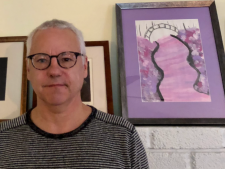
Brian Greene writes short stories, as well as journalism pieces on books, music, film, and visual art. His work has appeared in over 30 publications since 2008. His writing blog can be found at http://briangreenewriter.blogspot.com/ and he’s on Twitter @greenes_circles
.
.
___
.
.

Born in Athens, GA (1979) and raised in Jacksonville, FL, Otha Davis III (also known as Vakseen) is a self-taught, museum-exhibited artist and a multi-platinum music executive, producer & songwriter.
To visit his website, click here
.
.
Listen to a 1982 recording of the Gary Burton Quartet playing “Dreams So Real” (with Burton, vibes; Jim Odgren, alto sax; Steve Swallow, bass; Mike Hyman, drums)
.
.
.
Click here to read “Chromesthesia” by Shannon Brady, the winner of the 55th Jerry Jazz Musician Short Fiction Contest
Click here for details on the 56th Short Fiction Contest
.
.
.






